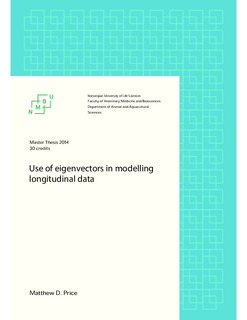| dc.description.abstract | The modelling of longitudinal data by a regression model generally utilises a set of basis functions of a certain type (polynomial, exponential, etc.) to be used as regressors in the model. Along with the regression coefficients, these basis functions define the interpolating functions for fitting the data.
These continuous functions can further be used to extrapolate values for points in time beyond those from the initial dataset, although the accuracy by which they may do so depends upon the nature of the dataset and the type and order of the interpolating function (where the order is the number of basis functions used). The accuracy of the extrapolation of data, and indeed the interpolation (fitting) of data, will depend upon how well the interpolating function takes into the account the covariance of the data. If the type of function does not represent the nature of the data well, the obtaining of accuracies will be problematic, particularly for the boundary regions of the data.
The covariance of the data can be decomposed into a set of eigenvectors, which re-parameterises the data into the directions of greatest to lowest variance, as is used in principal component analysis (PCA). By using the eigenvectors of the directions of greatest data variance as a set of basis vectors in a regression model, they have the potential to better fit the data than interpolating functions of the same order. It was therefore the objective of this study to investigate the use of eigenvectors in a regression for modelling longitudinal data, and compare it to existing models.
Additionally, the piecewise interpolation of the eigenvectors themselves was investigated to see if a regression using the resulting eigenvector-based function set was effective in extrapolating data beyond the time-points of the initial dataset.
The study utilised a simulated dataset for which covariance and noise variance could be known and controlled. It was found that an eigenvector-based model can indeed provide better fitting of the data, as well as extrapolation of data, than some existing functions (the Legendre polynomials and a modified version of the inverse polynomials in particular). However, results were not consistent, and the noise of the dataset needs to be better taken into account in order to better ascertain what advantage an eigenvector-based model truly has over existing models. | nb_NO |
